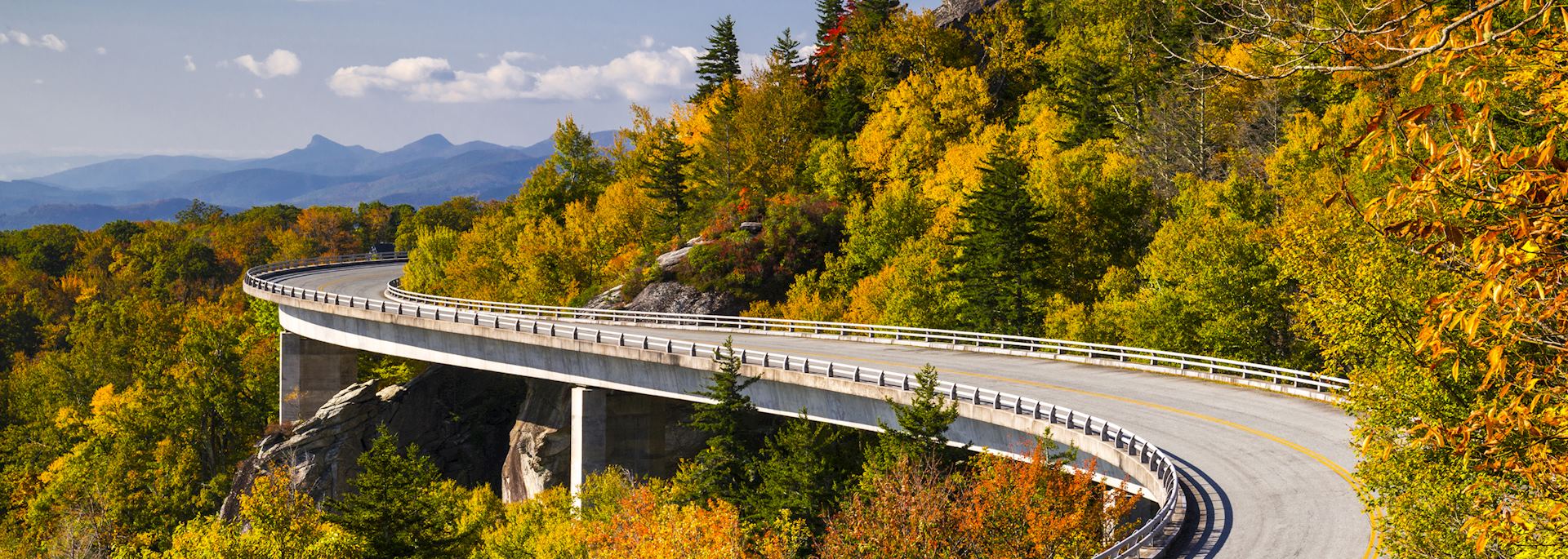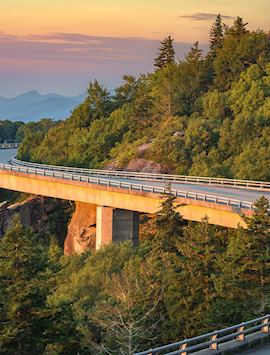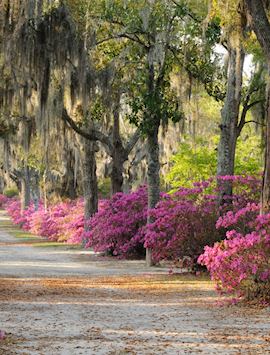By USA specialist Jude
Winding through the states of Virginia and North Carolina, a road trip along the Blue Ridge Parkway encompasses Civil War battle sites, huge national parks, and towns that hum with a vibrant music scene.
En route you can explore Shenandoah National Park and take in the blue haze of the parkway from some of the highest points of the Appalachian Mountains, and drive through Great Smoky Mountains National Park, where you can also explore on foot.
What is the Blue Ridge Parkway?
Often called “America’s Favorite Drive”, this road snakes through some of the region’s most attractive areas. You'll be able to take in sweeping vistas of valleys, tree-covered slopes, and panoramic views of distance-hazed mountains, as well as the plants and animals that thrive here thanks to the road’s protection.
Blue Ridge Parkway road trip in sections
Washington, the start of this trip
Washington DC is the logical starting point for anyone driving the Blue Ridge Parkway, although the road itself starts in Front Royal, the north entrance to Shenandoah National Park. It’s the largest international hub in the area, and you can quite easily spend a few days here after your flight, exploring many of the capital’s highlights. As the heart of US politics, the White House, Pentagon and National Archives — where you can view the Declaration of Independence — are just some of the many sites of interest.

Stopping at Front Royal
Pick up your rental car in Washington DC and drive two hours to Front Royal in Virginia. This small town is just a mile or so from the official starting point of the Blue Ridge Parkway, and the surrounding areas include some of the country’s pivotal Civil War battle sites, including Cross Keys and Kernstown. Gettysburg is just two hours north in Pennsylvania, if you want to take a slight detour before embarking on your drive down the Blue Ridge Parkway.

Driving into Shenandoah National Park
The road that snakes its way through Shenandoah National Park is known as Skyline Drive because you are at some of the highest points of the Appalachian Mountains along this part of the route. Surrounded by foliage, you’ll weave your way through the park, where there are plenty of places to stop and admire the views of the densely forested slopes. The blueish haze that the Blue Ridge Parkway is named for hangs in the air around the poplar, maple, birch, and ash trees. I’d recommend spending a couple of days exploring Shenandoah. The only hotel in the park that we suggest is Skyland Resort, a fairly rustic stay that’s right in line with the setting. Additionally, the Appalachian Trail walking route runs along the front of the building, making it a worthwhile stop if you’d like to explore the area on foot. If you’re not staying in the park, the rangers at the visitors facility can suggest a short walk.
I’d recommend spending a couple of days exploring Shenandoah. There’s only one hotel in the park, which is government owned and fairly rustic, but the Appalachian Trail walking route runs along the front of the building, making it a worthwhile stop if you’d like to explore the area on foot. If you’re not staying in the park make a stop at the visitors’ centre to embark on a circular walk for an hour or so.
Shenandoah is home to an interesting collection of wildlife, from black bears and deer to wild turkeys that you’ll often see from the car as they cross the road in front of you.

Driving into Charlottesville
From Shenandoah National Park you will travel across flatter meadows toward Charlottesville. If you’re not staying in the park itself, this compact city is the ideal base for exploring the southern part of the park.
Charlottesville is dominated by the University of Virginia, but away from the university, the city is pedestrian-friendly, with quaint, boutique shops, an old-fashioned cinema and, at the far end of town, a pavilion where regular live performances are held. The area is also known for its wineries, if you’d like to include a tasting tour.
The town is also an hour-long drive from the homes of three of the country’s founding fathers. You can take tours around these properties, which include Thomas Jefferson’s Monticello — a UNESCO World Heritage Site — as well as James Madison’s grand Montpelier and James Monroe’s timber homestead, Highland.

Stopping off in Roanoke
After Charlottesville, the mountains of the northern Appalachian Mountains begin to drop away. This is the midway point of the drive, where you’re surrounded by waves of forested hillside.
I’d recommend stopping in Roanoke to break up the eight or nine-hour drive from Charlottesville to Boone — the narrow roads here require slow driving. However, Interstate 81 runs nearby if you want to speed up some of your journey on this less-scenic highway.
Nearby you’ll find the Blue Ridge Music Center. Here you can learn about the musical history of the region, where old-time and bluegrass became popular because of the mixture of migrant workers passing through the area.

Scenic drive to Blowing Rock and Boone
Nestled in the foothills of the southern Appalachians, just over the border in North Carolina, the towns of Blowing Rock and Boone are a three-hour drive along the picturesque parkway from Roanoke. Here, you’re surrounded by rolling hills covered in lush woodland that shelters a variety of wildlife including bears, wild turkeys, and bobcats.
It’s worth spending a full day exploring the park, which is great for outdoor pursuits such as cycling and easy walks around a number of the small lakes that dot the landscape.

Asheville
Leaving the southern Appalachians, your next stop is the city of Asheville. Just 15 minutes off the parkway, this university city has something of a bohemian atmosphere, with the undulating Blue Ridge Mountains as its backdrop.
There’s a strong musical influence in Asheville, which you can hear throughout the many small, locally owned bars. The city, however, doesn’t like to pigeon-hole itself into any one genre. Instead, if you can play an instrument, you're welcome to get up on stage and perform. Part of the appeal is the fact that you never really know what you’re going to hear, and the type of music you’ll listen to will vary from one bar to another.
I’d recommend spending three nights in Asheville because there’s plenty to see and do in the area. Part of the city is taken up by the Biltmore estate, constructed by George Vanderbilt in the 1800s. This grand property overlooks the northern tip of Great Smoky Mountains National Park, and I’d allow a couple of hours to explore under your own steam. The first room of the château-style house, with its palm trees and glass roof, is reminiscent of a greenhouse, the exotic plants that grow here an indication of the wealth of the household.
A winery was also established on the estate and this is still producing wine. As part of your visit, you can enjoy complimentary wine tasting in Ampler Village, an area used to accommodate the Vanderbilt’s best-loved servants, just a ten-minute shuttle ride from the house.
At the bottom of the estate lies Biltmore Village, which Vanderbilt built for his servants. Today, it’s been converted into a chic shopping area.
Don’t miss the opportunity to sample some local dishes in the city that's known for its barbecues. You’ll find plenty of eateries where you can try traditional Appalachian dishes, like pimento cheese, cornbread and beans, country ham and greens, and hominy grits, a smooth porridge that’s a lot like polenta.

Driving through Great Smoky Mountains to Cherokee
From Asheville, head toward the Great Smoky Mountains, America’s most visited national park. You’ll find plenty of ways to fill your time here. Hike on one of the many walking trails and cross Mile High Swinging Bridge, the country’s highest suspension footbridge, to reach the peak of Grandfather Mountain for panoramic views of your misty surroundings. Nearby Gatlinburg, Tennessee, is a great base.
It’s simple to explore on your own, however I can also arrange a guided 4x4 tour into the peaceful side of the Rockies. Your guide will point out the local flora and fauna as you drive through Cades Cove, one of the best places for spotting wildlife. Along the way, you’ll also take in some of the region’s pioneer history, including a water-powered grist mill, churches, and cabin homes.

How long is the Blue Ridge Parkway?
This route is 750 km (470 miles) long, and it’s worth taking two weeks to allow enough time to comfortably explore the various highlights along the way.
What’s the best car for this road trip?
I’ll reserve you an intermediate 4x4, which can handle some of the steeper inclines within the national parks.
When is the best time to drive on the Blue Ridge Parkway?
The best time to drive along the Blue Ridge Parkway is from mid-May to October. You’ll encounter warm weather, green forests, and lively towns. October brings truly glorious autumn foliage but also the thickest crowds. If you prefer to avoid visitors altogether, consider late April or early May, though the higher elevations can remain winter-bare for several weeks.
November to March, most of the facilities along the road shut down and the road is more likely to have long stretches shut for maintenance or because of ice and snow.
What is the speed limit on Blue Ridge Parkway?
The speed limit along the Blue Ridge Parkway is 40 to 70 km per hour (25 to 45 miles per hour), so relax and slow down. Not only is it safer on the serpentine curves, you’ll also have more time to take in the views. And, thanks to the abundance of local wildlife, you might need to brake for an ambling bear or a lumbering turtle.
What is the most beautiful spot on the Blue Ridge Parkway?
“Most beautiful” is subjective, of course, but the Linn Cover Viaduct offers sweeping views as it snakes along the face of Grandfather Mountain in North Carolina. (It’s also considered an engineering marvel, built to reduce the impact on the local ecosystem.)
Known by the Cherokee Nation as “the river of many cliffs”, Linnville Falls is another highlight on Grandfather Mountain. I suggest spending an afternoon here. After admiring the falls, enjoy a picnic lunch at the tables, and then take one of the trails nearby — you can choose between the moderate Erwin’s View Trail and the more strenuous Linville Gorge Trail.
Mabry Mill, in Virginia, is a highlight in spring and early summer, when it’s surrounded by flowers. Plan to spend some time watching demonstrations of early settler life here and perhaps stroll along the brief, easy trail that winds through the surrounding forest of sycamores and poplars. If you visit on a Sunday, stay for dancing and music in the afternoon.
Plan your self-drive along the Blue Ridge Parkway
Start thinking about your experience. These itineraries are simply suggestions for how you could enjoy some of the same experiences as our specialists. They're just for inspiration, because your trip will be created around your particular tastes.
View All Tours in The USAFurther reading
- Self-drive holidays in the USA
- Exploring the American South: Georgia and the Carolinas
- Route 66 holidays
- Self-driving in Hawaii
- Self-driving in the Rockies
- Self-driving through Arizona & Utah in America’s Southwest
- Planning a Blue Ridge Parkway road trip: everything you need to know before setting off
- Self-drive holidays in Florida
- Self-drive holidays in California



